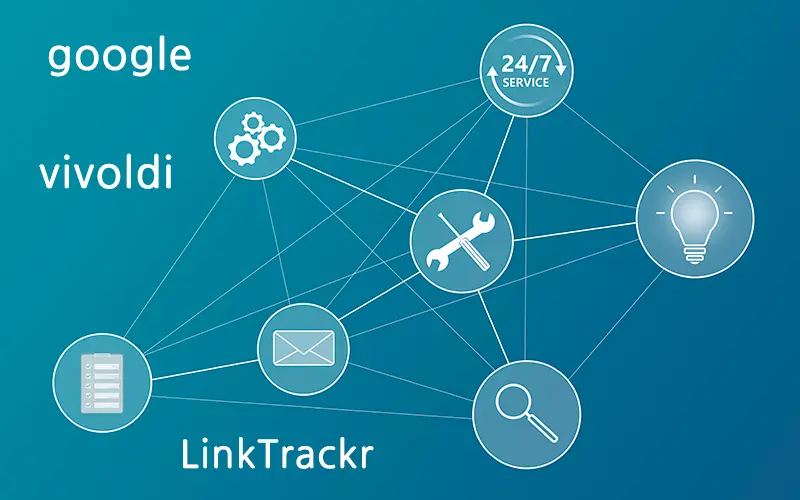Tracking links play an important role in digital marketing campaigns, allowing businesses to analyze the effectiveness of their marketing efforts and optimize their strategies.
By using tracking links, or URL shorteners, businesses can collect data on click-through rates, conversion rates, and other key metrics. This comprehensive guide aims to demystify tracking links by walking you through the process of creating them step-by-step and providing useful insights on how to analyze the data generated.
Whether you're a marketing professional looking to improve your skills or a business owner looking to maximize the effectiveness of your online campaigns, this guide will give you the knowledge you need to master the link tracking feature.
1. What are tracking links and why are they important?
Tracking links, also known as campaign links or custom URLs, are links created specifically for the purpose of tracking the performance of a marketing campaign. These links typically contain unique parameters or tags that allow businesses to collect data about various aspects of their campaigns.
But why are tracking links important? Because links provide businesses with valuable insights into the effectiveness of their marketing efforts. By tracking clicks, conversions, and other metrics associated with specific tracking links, businesses can learn which campaigns drive the most traffic, where leads are coming from, and which channels convert the best.
With this information, businesses can optimize their marketing strategies, allocate resources more effectively, and make data-driven decisions that ultimately lead to better results. In short, link tracking is an essential tool for any business looking to maximize the effectiveness of their marketing campaigns and drive measurable success.
2. Benefits of using tracking links in your marketing campaigns

Using tracking links in your marketing campaigns can provide a number of benefits to your business. Learn more about some of the key benefits:
- Accurate and actionable data: Tracking links allow you to collect accurate data on various aspects of your campaigns, such as clicks, conversions, and engagement rates. This data can help you make informed decisions and fine-tune your marketing strategy to achieve better results.
- Comprehensive campaign analysis: Tracking links allow you to track the performance of each campaign individually. This allows you to compare the effectiveness of multiple campaigns, identify the best performing campaigns, and replicate success in future campaigns.
- Attribution insights: Tracking links help you understand which marketing channels are driving the most traffic and generating the highest conversion rates. This information is crucial for allocating resources wisely and maximizing your return on investment.
- A/B testing and optimization: You can test different versions of your tracking links to determine which message, visual, or call-to-action is most effective. Through this iterative process, you can optimize your campaigns for better results.
In conclusion, using tracking links in your marketing campaigns can give you valuable insights and allow you to make data-driven decisions, resulting in improved results and a higher return on investment.
3. Understand the components of a tracking link

To create tracking links effectively, it's important to understand the components of a tracking link. A tracking link consists of a few key elements, each of which fulfills a specific purpose. Let's take a closer look at them
- Destination URL: This is the final URL you want to direct your audience to. It can be a specific landing page, product page, or any other webpage you want them to visit.
- Tracking parameters: Tracking parameters are added to the destination URL to identify the specific campaign or source being tracked. This helps to distinguish data from different marketing channels and campaigns.
- UTM parameters: UTM parameters are tags that are added to tracking links to provide additional information about the source, medium, and campaign associated with each link. They are essential for accurate data analysis and attribution.
- Call to action (CTA): A call-to-action is a message or link that prompts a user to take a specific action, such as clicking a tracking link. It should be compelling and clear to engage users.
By understanding these components, you can create tracking links that allow you to accurately track and analyze your marketing efforts. In the next section, we'll explore different methods and tools for creating tracking links efficiently, so stay tuned!
4. Creating effective tracking links: best practices and tips
Now that you have a solid understanding of the components involved in creating tracking links, let's talk about best practices and tips for creating effective tracking links.
First and foremost, it's important to stay organized with your tracking links. Maintain a consistent naming convention and folder structure so that you can easily track and analyze the performance of each link. This will save you time and effort in the long run.
Second, always test your tracking links before deploying them. Make sure it redirects to the correct destination URL, and that your tracking parameters and UTM tags are working correctly. Testing ensures that the link works as intended and that you can trust the data it generates.
It's also important to use descriptive and meaningful UTM parameters. Name your sources, mediums, and campaigns consistently - this will help with data analysis and give you a clear picture of how each marketing channel and campaign is performing.
Consider making your tracking links shorter - long, complicated links can be frustrating for users, which can lead to lower click-through rates. Utilize URL shortening tools to create concise, visually appealing links that are more likely to be clicked.
Finally, analyze the data generated from your tracking links regularly. Identify trends, track conversions, and adjust your marketing strategy accordingly. Understanding how each link performs can help you optimize your campaigns and improve your overall marketing effectiveness.
In the next section, we'll explore popular tools and methods for efficiently creating tracking links. Stay tuned to discover the best options for your tracking link needs!
5. Tracking Link Tools and Software to Consider

Now that we've covered the best practices for creating effective tracking links, let's take a look at some popular tools and software that can streamline the process and improve your tracking capabilities.
One tool we highly recommend is Google Analytics. This powerful platform allows you to create custom tracking links using UTM parameters and provides in-depth analytics to measure the effectiveness of your campaigns. With Google Analytics, you can track the performance of your links, measure conversions, and gain valuable insights into the behavior of your audience.
Another popular option is Vivoldi, a URL shortening service that also offers tracking features. With Vivoldi, you can create short, trackable links that can be easily shared across different channels. With real-time analytics and detailed reports, you can monitor click-through rates, measure engagement, and optimize your marketing efforts.
As a link creator, knowing which pages and how many users clicked on your link to get to your website is a great marketing tool, and pages that aren't getting enough clicks can be beefed up with more content or filled with meaningful, trending keywords.
If you're looking for a comprehensive solution with advanced features, we recommend using dedicated tracking link software like ClickMeter or LinkTrackr. These tools offer extensive tracking and analytics features, making it easy to create, monitor, and analyze tracking links accurately.
Whether you use Google Analytics, Vivoldi, or dedicated tracking link software, it's important to choose the right tool for your tracking needs. Take the time to research and test different options to find one that fits your goals and preferences.
The following sections discuss some advanced link tracking techniques, including dynamic link tracking and deep linking. These strategies can further enhance your tracking capabilities and help you personalize the user experience based on their interactions with your links.
6. Analyzing and interpreting tracking link data
Now that you know about the tools and software that can help you track links, it's time to learn more about how to analyze and interpret your tracking link data. This step is crucial to understanding how your campaigns are performing and making informed decisions to optimize your marketing efforts.
One of the first metrics you'll want to pay attention to is your click-through rate (CTR), which is the percentage of people who clicked on your tracking link out of the total number of impressions or views. A high CTR means that your link is attracting attention and generating interest.
In addition to CTR, you should also analyze your conversion rate. This metric shows the percentage of people who took the desired action, such as making a purchase or filling out a form, after clicking on your tracking link. A high conversion rate means that your links are driving meaningful results.
Another important aspect to consider is the source of your traffic. By analyzing where your clicks and conversions are coming from, you can determine which channels are performing well and allocate resources accordingly. This data can also help you refine your targeting and reach your desired audience more effectively.
It's also important to keep an eye on engagement metrics like average time on page and bounce rate. These insights indicate how engaged your audience is with your content and whether they find it valuable. By understanding your audience's behavior and preferences, you can adjust your strategy to better meet their needs.
In the next section, you'll learn about some advanced link tracking techniques, including dynamic link tracking and deep linking. These strategies allow you to take your tracking to the next level and create personalized user experiences based on their interactions with your links.
7. Troubleshooting common tracking link issues
In this section, we discuss some common issues you might encounter when creating and utilizing tracking links. Tracking links are a very useful tool for understanding the performance of your marketing efforts, but they are not immune to technical glitches or human error.
One common issue is misaligned tracking parameters. Sometimes the parameters in a tracking link don't match the parameters specified in the tracking software. This can result in inaccurate data or a complete failure of the tracking. To resolve this issue, double-check the parameters of the link and the tracking software to make sure that they are consistent.
Another issue is improper implementation of the tracking script or code. If the tracking code is not properly placed on your website or landing page, it can result in incorrect tracking or no tracking at all. Follow the instructions provided by your tracking software and make sure that your tracking code is implemented correctly.
Additionally, there are often inconsistencies in tracking data between tracking software and other analytics tools, such as Google Analytics. These discrepancies can be caused by differences in tracking methodologies or data collection techniques. To resolve this issue, compare data from multiple sources to see if there are any significant differences. If necessary, contact your tracking software's support team to help you resolve any discrepancies.
Finally, if you notice a sudden drop in your click-through rate or conversion rate, there could be an issue with broken links, slow page loading, or poor content quality. Monitor your tracking data regularly and check in periodically to ensure that your links are working properly and that your content remains relevant and engaging.
By addressing these common tracking link issues, you can ensure the accuracy of your data and make informed decisions to optimize your marketing campaigns.
8. Conclusion and key takeaways

In conclusion, understanding and mastering tracking links is essential to successfully analyzing the performance of your marketing efforts. Common problems with tracking links include misaligned parameters, improper implementation of tracking scripts, and inconsistent tracking data, but these issues can be resolved.
Always double-check that the parameters in your tracking links and software are consistent to ensure that you have accurate data. Follow the instructions provided by your tracking software to properly place the tracking code on your website or landing page. Compare data from multiple sources to identify any significant discrepancies and contact support if necessary.
Also, monitor your tracking data regularly to identify any issues that may be affecting your click-through rate or conversions. Conduct periodic checks to verify the functionality of your links and maintain the quality of your content.
By addressing these common issues, you can optimize your marketing campaigns and make data-driven decisions.
If you find analyzing marketing data difficult or are a beginner, you can use Vivoldi, a shortened URL service, to do it all at once. Vivoldi analyzes a huge amount of link clicks and traces and presents the data in visual graphs and statistics, making it easy for anyone to understand and take a step forward in marketing.
Thank you.



